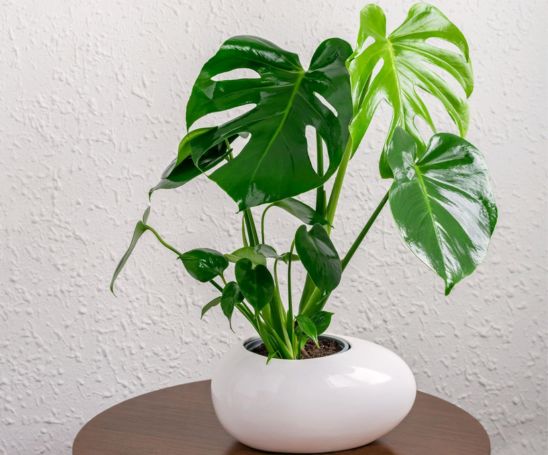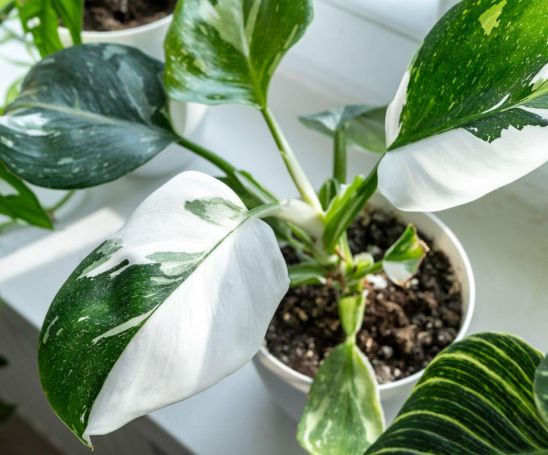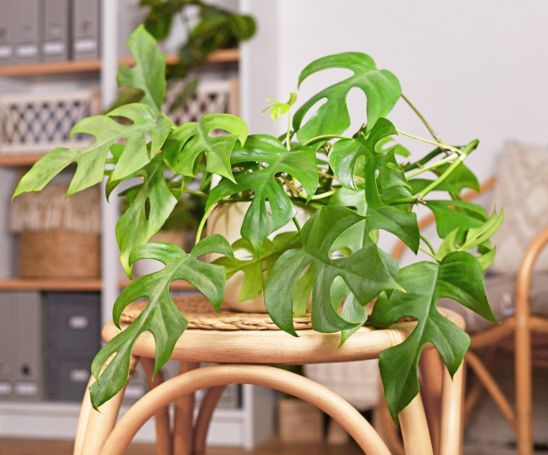Variegated Rhaphidophora Tetrasperma is a popular houseplant for its unique foliage and fast-growing nature. Choosing this plant for your collection implies knowing how to care for it properly. The best way to care for Rhapidophora tetrasperma, including varieties, growth habits, ideal location, optimal light and soil conditions, watering and fertilizing tips, temperature and humidity requirements, pruning and maintenance techniques, and propagation. By the end of this article, you will have all the information you need to successfully care for your mini Monstera plant and watch it thrive in your home. Find out how to grow this striking tropical plant in your home, as well as its unique features, origin, and care requirements.
What is Variegated Rhaphidophora Tetrasperma?

Rhaphidophora tetrasperma variegated, often referred to as “Mini Monstera,” has gained quite popularity for its resemblance to Deliciosa. Variegated Rhaphidophora Tetrasperma, scientifically known as Rhaphidophora Tetrasperma ‘Variegata,’ is a tropical climbing plant native to Southeast Asia. It belongs to the Araceae family and is closely related to the famous Monstera deliciosa. The shingling growth pattern of this plant allows it to scale trees and other supports, reaching up to 15 feet in height in its natural habitat.
Scientific Name: Rhaphidophora tetrasperma
Plant Type: Tropical
Average Height: 4-5 feet (121-152 cm) indoors
Average Width: 1-2 feet (30 – 60 cm)
Growth Rate: Fast
Produces Flowers: No
Common Pests: Spider mites, mealybugs
Level of Care: Moderate
Different types of variegated Rhaphidophora tetrasperma

The Rhaphidophora tetrasperma, also known as the Monstera minima, Mini Monstera, Philodendron minima, Philodendron Ginny, or Philodendron Piccolo, is an elegant houseplant. Dive into the world of Rhaphidophora tetrasperma albo variegated, explore the stunning colors of Rhaphidophora tetrasperma aurea variegata, learn about the unique features of Rhaphidophora tetrasperma mint, discover the elegance of white variegated Rhaphidophora tetrasperma, and find out which type suits your taste and style.
Rhaphidophora tetrasperma albo variegated
Experience the mesmerizing beauty of Rhaphidophora tetrasperma albo variegated and discover its unique variegation patterns. This variety features white or cream-colored variegation on its leaves, creating a striking contrast against the green foliage. Some plants have half-moon leaves, and others are almost white or cream.
Rhaphidophora tetrasperma aurea variegata
Rhaphidophora tetrasperma aurea variegated, which has yellowish variegation instead of white. This variety exhibits variegation with shades of yellow or gold on its leaves, and The variegation adds a vibrant and unique appearance to the plant. Variation in chloroplasts can be caused by defective chloroplasts which have less chlorophyll, reactive oxygen species (ROS), and sometimes, carotenoids accumulation. Enhance the variegation of this stunning plant and create the ideal conditions for its growth.
Rhaphidophora tetrasperma mint
Rhaphidophora tetrasperma mint variegated is a plant with glossy green leaves with streaks, marbling, or blotches of mint green (a lighter shade of green). Variegated Rhaphidophora tetrasperma are caused by sectoral chimera or mutations on meristemic cells. The mint variegation can create a fresh and visually appealing look. Discover the versatility of Rhaphidophora tetrasperma mint in different settings.
white variegated rhaphidophora tetrasperma
Admire the exquisite beauty of white variegated Rhaphidophora tetrasperma. The white variegated patterns can take various forms, such as imperfections, streaks, or marbling. Use it as a striking centerpiece in your interior design.
Rhaphidophora Tetrasperma Growth Habits

Understanding the growth habits of Rhaphidophora tetrasperma is essential for successful care. This plant develops its distinctive foliage through different stages of growth and maturation. A properly cared for plant can reach heights of up to 12 feet (365 cm) outdoors and four to five feet (121-152 cm) indoors. Its vining characteristics require proper support for healthy growth. Exploring the natural behavior and development of this plant provides valuable insights for nurturing it.
Best Location for Rhaphidophora Tetrasperma
Discover the perfect spot to showcase your Rhaphidophora tetrasperma, taking into account its lighting requirements and the impact of temperature and humidity. The light levels and humidity conditions necessary for this plant’s survival can be provided in kitchens and bathrooms facing southwest or west.
Rhaphidophora Tetrasperma for Caring
| Condition | Recommendation |
| Growth habits | Upright, climbing, grows fast |
| Lighting needs | Bright, indirect |
| Watering | Water when top inch of soil is dry |
| Lighting needs | Bright, indirect |
| Toxicity | Toxic to people and pets if ingested |
| Fertilization type | Nitrogen-rich liquid fertilizer |
| Temperature | 55 to 85℉ |
| Humidity | 30% |
| Best location | Kitchen or bathroom |
| Pruning | Occasionally needed to maintain size and shape |
How fast does variegated rhaphidophora tetrasperma grow?

The growth rate of variegated Rhaphidophora tetrasperma varies depending on various factors. However, with the right care and conditions, this plant can grow at a moderate pace. Promote healthy growth by providing adequate light, proper watering, and suitable temperature and humidity levels. Maximize its growth potential with these tips!
Optimal Lighting for the Variegated Rhaphidophora Tetrasperma
The best place to place your plant for optimal light is near a north or east-facing window. Direct sunlight can scorch its delicate leaves and cause irreparable damage. To strike the perfect balance, place your Variegated Rhaphidophora Tetrasperma near a bright window where it can receive filtered sunlight throughout the day.
Ideal Soil for Rhaphidophora Tetrasperma
It grows best in light, well-draining soil, which keeps moisture without becoming waterlogged. A mix of peat moss, perlite, and potting soil works well. Avoid heavy or compacted soil to prevent root rot. Ensure good aeration for healthy root development. Organic matter can improve soil fertility.
How often to water rhaphidophora tetrasperma?
Water the variegated rhaphidophora tetrasperma when the top inch of soil is dry, adjusting frequency based on environmental conditions. Check humidity levels and use a moisture meter for accurate soil moisture assessment. Avoid overwatering to prevent root rot.
How often to fertilize rhaphidophora tetrasperma?
Fertilizing the variegated rhaphidophora tetrasperma every 2-4 weeks during the growing season is recommended. Use a balanced liquid fertilizer, diluted to half strength, following the package instructions for dosage and application method. Avoid overfertilization to prevent nutrient burn. Organic fertilizers can be considered for long-term soil health.
Temperature and Humidity
Plants grow well at a temperature range of 55 to 85°F (12 to 29°C). The humidity level should be kept above 50% for Tetrasperma variegated. Increase indoor humidity with a humidifier or pebble tray. Protect the plant from drafts and temperature fluctuations.
Pruning and Maintenance
Pruning and maintenance are crucial aspects of caring for variegated rhaphidophora tetrasperma plants. These stunning specimens, with their beautifully patterned leaves, require regular attention to ensure healthy growth and maintain their attractive appearance.
When it comes to pruning, it is essential to remove any dead or yellowing leaves promptly. This not only enhances the plant’s aesthetics but also prevents the spread of diseases. Additionally, trimming back long vines can help promote bushier growth and prevent the plant from becoming leggy. Remember to use sharp, clean pruning shears to make clean cuts and avoid tearing the foliage.
For these plants to thrive, regular maintenance is also essential. Keep an eye out for pests such as mealybugs or spider mites that can infest the leaves and stems. Use organic insecticides or damp rags if you notice any signs of pest infestation. Moreover, remember to provide adequate light conditions, moisture levels, and appropriate fertilizer to support healthy growth.
By employing proper pruning techniques and maintaining vigilance in upkeep activities for variegated rhaphidophora tetrasperma plants, you can enjoy their beauty while ensuring their longevity and vitality in your space.
Propagation Tips for Rhaphidophora Tetrasperma
To propagate Rhaphidophora Tetrasperma, take 4-6 inch stem cuttings with at least two nodes. Remove bottom leaves and dip in rooting hormone. Place in well-draining soil or water, and provide warmth and humidity to encourage rooting.
Stem Cuttings
To propagate Rhaphidophora Tetrasperma, select a healthy stem with one node and leaf. Cut below the node, remove lower leaves, dip in rooting hormone, and plant in well-draining soil. Keep moist with indirect light for root and new growth.To begin, you’ll need the following tools:
- Clean, sharp scissors or a knife
- A jar or container filled with water
- A healthy parent plant
Air Layering
Air layering is a propagation technique for the Variegated Rhaphidophora Tetrasperma plant. It involves creating a wound on the stem, wrapping it with rooting hormone and moss, and allowing new roots to grow before cutting it off and planting it as a new plant. To do air layering, you will need:
- A sharp knife
- A healthy branch with a node
- Plastic wrap
- Sphagnum moss or other rooting medium
- Ties or rubber bands
How To Repot Rhaphidophora Tetrasperma?
To repot a Rhaphidophora Tetrasperma, also known as a mini Monstera or Philodendron Minima, you can follow these steps:
- Choose the right time. Repotting a Rhaphidophora Tetrasperma in spring or early summer is the best time.
- Pick a pot that is one size larger than the current one. If you want your new pot to avoid waterlogging, ensure it has drainage holes.
- Place a layer of small rocks or broken pottery at the bottom of the pot to aid in drainage.
- Prepare the soil Rhaphidophora Tetrasperma prefers a well-draining, rich potting mix. You can create a blend by combining equal parts of peat moss, perlite, and compost.
- Carefully remove the plant from its current pot. You can tap the sides of the pot or use a trowel to loosen the soil.
- Check the roots for damage or rot. Trim any brown or mushy roots with clean and sterilized pruning shears.
- Ensure that your plant is at the same depth in the new pot.
- Fill the pot with the prepared potting mix, ensuring that the roots are covered, and there are no large air pockets around them.
- Press the soil after repotting, and give the Rhaphidophora Tetrasperma a thorough watering to help settle the soil. Allow any excess water to drain out of the pot.
- Place the plant in a bright, indirect light location. Avoid direct sunlight, as it may scorch the leaves.
Common Problems and Solutions When Caring for Rhaphidophora Tetrasperma
When caring for Rhaphidophora Tetrasperma, common problems include overwatering, lack of humidity, pest infestation, incorrect lighting, and improper fertilization. Avoid root rot by letting the top inch of soil dry out. Provide high humidity through a humidifier or pebble tray. Check for pests like spider mites regularly and control them with insecticidal soap. Ensure bright, indirect light, and use balanced fertilizer once a month.
Pest Issues
When it comes to caring for variegated Rhaphidophora Tetrasperma, pest issues can sometimes arise. It’s important to be vigilant and check for common pests like spider mites, mealybugs, and scale insects. Using insecticidal soap can help control and eliminate these pests. Here are some steps for getting rid of spider mites:
- To remove mites and webs, wipe the leaves with a damp cloth.
- Treat the plant with an insecticidal soap or neem oil.
- Make sure you follow the product label instructions.
- Follow your plant’s progress and repeat the treatment if needed.
Disease Issues
Regularly inspect your variegated Rhaphidophora tetrasperma for signs of disease. Maintain proper humidity levels and avoid overwatering to prevent diseases. Promptly treat any detected diseases and consult an expert if unsure. Use sterile tools and optimal conditions to minimize disease risk. Follow these guidelines to prevent and treat root rot:
- The soil should be well-draining and the pot should be chunky and medium in size.
- To avoid overwatering, water only when the top inch of the soil is dry.
- The roots should be inspected and any affected portions should be cut away if root rot is evident.
- It’s time to repot your plant in fresh, well-draining soil and a clean pot.
Rhaphidophora Tetrasperma Common Questions
Is variegated Rhaphidophora tetrasperma rare?
Variegated Rhaphidophora tetrasperma is considered rare due to its unique and sought-after variegation. It is popular among collectors and enthusiasts, making it challenging to find and expensive. Specific care is required to maintain its variegation, adding to its rarity. Buy from reputable sellers to ensure authenticity.
How do you care for Rhaphidophora tetrasperma variegated?
To care for Rhaphidophora tetrasperma variegated, ensure it receives bright, indirect light. Keep the soil moist but well-drained and provide humid conditions. Regular pruning promotes neatness and fuller growth.
How do you propagate variegated Tetrasperma?
To care for Rhaphidophora tetrasperma variegated, ensure it receives bright, indirect light. Keep the soil moist but well-drained and provide humid conditions. Regular pruning promotes neatness and fuller growth.
What is the most expensive Rhaphidophora tetrasperma?
The rare variegated Rhaphidophora tetrasperma variegata, also known as the Monstera Minima (variegata), is considered the most expensive variety. This beautiful philodendron plant has glossy green leaves with beautiful white variegation. While the regular Rhaphidophora tetrasperma is not expensive, the exact plant variegated version, Rhaphidophora Tetrasperma Variegata, can fetch a higher price due to its rarity and unique appearance.
Is there a variegated Rhaphidophora Tetrasperma?
Yes, there is a variegated Rhaphidophora Tetrasperma. This type of plant features leaves with white or yellow stripes. It requires bright, indirect light and well-draining soil. Proper watering and humidity levels are also crucial for its success.
Is Rhaphidophora Tetrasperma Toxic?
Rhaphidophora Tetrasperma can be toxic to pets and humans if ingested. The plant’s sap may also cause skin irritation. To ensure safety, keep the plant out of reach of children and pets. If ingestion occurs, seek immediate medical attention.
Is Philodendron Minima the Same as Tetrasperma?
No, Philodendron Minima and Philodendron Tetrasperma are not the same plant. While they may have some similarities in appearance, they are two different species within the Philodendron genus.
How Do You Identify Rhaphidophora Tetrasperma?
Rhaphidophora tetrasperma has smaller leaves compared to Monstera deliciosa, around 2-4 inches in diameter. The leaves have distinct fenestrations or splits, like Swiss cheese plants, but they are usually more pronounced and elongated in Rhaphidophora tetrasperma. Rhaphidophora tetrasperma tends to grow in a more compact and bushy manner compared to Monstera deliciosa.
It often produces many stems that branch out from the base, creating a fuller appearance.
Conclusion
Caring for variegated Rhaphidophora Tetrasperma requires a deep understanding of its growth habits, ideal location, lighting, soil, watering and fertilizing schedule, as well as temperature and humidity conditions. Regular pruning and maintenance are also necessary to ensure its health and appearance. Additionally, propagation methods such as stem cuttings and air layering can be utilized to expand your collection. While pests and diseases may pose challenges, being proactive in preventing and addressing these issues will help keep your plants thriving. There are several cultivars of variegated Rhaphidophora Tetrasperma, each with unique characteristics and requirements, so it’s important to research and tailor your approach. You can enjoy the beauty and lushness of these stunning plants in your own home with proper care.
You may also like peperomia







